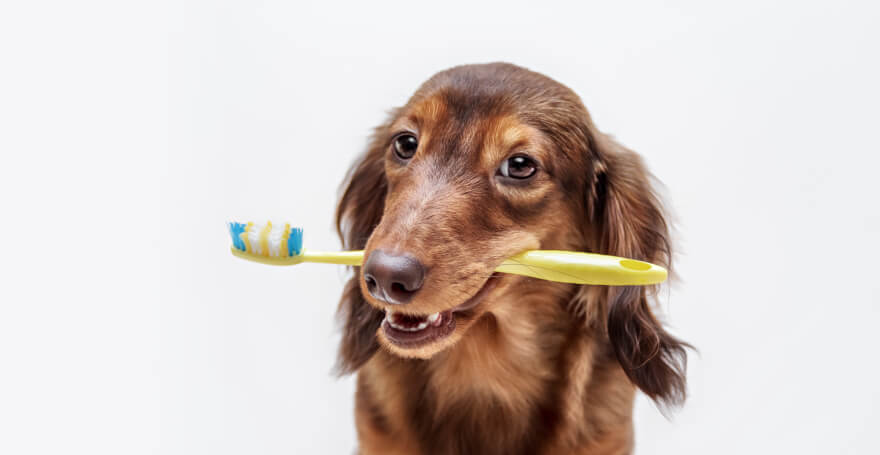4 Tips for Curing Bad Dog Breath
We love our dogs, but “Doggy-breath” stinks! What can a dog owner do?
In honor of February being Pet Dental Health Month, we have some tips and information on keeping your dog’s mouth fresh and clean.
Our dogs and cats may be born with pearly whites, but just like us, if teeth are not cared for, they will become diseased. No one wants to lose teeth, and your pets are no exception. Tooth decay and dental disease can cause chronic pain. Plus, the bacteria that accumulates in the mouth is very harmful to the entire body, especially the kidneys and heart.
1. Bad dog breath, or halitosis, is a sign that bacteria is in there!
Bacteria love to live and grow in the dark, damp corners between teeth, especially around stuck food particles. Just like your teeth need brushing every day, your dog’s mouth needs attention, too! Teeth brushing will help, and this is something that you can accomplish with some training. Get comfortable with approaching your dog’s mouth, lifting the lip and brushing the teeth along each side of the mouth. Use a pet toothbrush or finger toothbrush and pet-specific paste, which is formulated with flavors your dog and cat will love. Never used human toothpaste, it can make your pet very sick!
Here are two great videos to help you get started brushing:
2. Along with brushing, other things will help!
Diets specially formulated for dental health really do work! The kibbles are shaped differently, and are larger, encouraging abrasion of the larger chewing teeth in the back of your dog’s mouth. Look for dental diets from Hills® and Purina® Veterinary Diets.
Many chew treats and toys are designed with pet dental health in mind, and some have ingredients to prevent bacteria and improve breath. We especially love the OraVet® chews for dogs, which even help to create a barrier to stop plaque buildup.
Unsure if a diet or product really works? Look for the “Veterinary Oral Health Council-Approved” seal on the product. The VOHC only recognizes products that meet pre-set standards of reducing plaque and tartar in dogs and cats. You can check out their approved products at the VOHC website.
3. Professional dental cleaning is important!
It is so important for your pet to have professional teeth cleaning! Over 75% of pets will develop some form of dental disease by 3 years or age! A dental cleaning should be done BEFORE the disease gets severe, and your veterinarian will clean every tooth, especially under the gums, to help prevent more advanced problems, like periodontal disease. Along with cleaning and polishing, survey radiographs are often taken to be sure that nothing deeper is brewing. This procedure should always be done under anesthesia with patient monitoring. We know this sounds scary, but anesthesia keeps your pet safe, with a breathing airway and appropriate medicines to reduce stress, anxiety and pain. Check out some great information about this topic on the AAHA website and be sure to talk to your veterinarian about routine dental cleanings for your dog or cat.
4. A pet “dental disaster” is always easier to prevent than treat!
Ignoring the danger signs is always a bad idea. Take a regular look inside your dog or cat’s mouth for signs of redness, swelling, bleeding gums, and tartar build up. Worn or broken teeth are especially prone to tooth root abscesses. Are there any lumps or bumps inside or around the mouth? Is your dog avoiding his hard treats? All of these signs are indicators of dental disease. Periodontal disease is an infection between the teeth and the gums that causes swelling, loose teeth and pain. If we forget the prevention, these issues cannot be reversed and your dog or cat will need to have major dental work and likely tooth extractions. We want our pets around as long as possible. Advanced periodontal disease will shorten your pet’s life and affect the quality of his life!
So, stop and smell your dog kisses and take the time, especially this month, to care for your dog’s teeth. You can be sure that he – and your entire family – will thank you!
